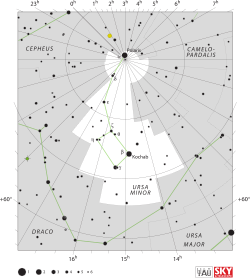Ahfa al Farkadain
| Observation data Epoch J2000 Equinox J2000 |
|
|---|---|
| Constellation | Ursa Minor |
| Right ascension | 15h 44m 03.5193s |
| Declination | +77° 47′ 40.175″ |
| Apparent magnitude (V) | +4.32 |
| Characteristics | |
| Spectral type | A3Vn |
| U−B color index | +0.05 |
| B−V color index | +0.04 |
| Astrometry | |
| Radial velocity (Rv) | –13.1 km/s |
| Proper motion (μ) |
RA: 20.07 mas/yr Dec.: –2.50 mas/yr |
| Parallax (π) | 8.68 ± 0.47mas |
| Distance | 380 ± 20 ly (115 ± 6 pc) |
| Absolute magnitude (MV) | −0.98 |
| Details | |
| Luminosity | 227 L☉ |
| Other designations | |
| Database references | |
| SIMBAD | data |
Zeta Ursae Minoris (ζ UMi, ζ Ursae Minoris) is a star in the constellation Ursa Minor.
It has been called Akhfa al Farkadain, from the Arabic أخفى الفرقدين aḫfa al-farqadayn, meaning "the dimmer of the two calves". It is then paired with η Ursae Minoris as Anwar al Farkadain, "the brighter of the two calves". The names may originally refer to a pair of Ibexes, and are more properly applied to γ UMi and β UMi respectively, the brighter two stars in the rectangle of Ursa Minor.
Zeta Ursae Minoris is a white stellar class A-type main sequence star with an apparent magnitude of +4.28. It is approximately 380 light years from Earth.
Despite its classification as a main sequence dwarf star, Zeta UMi is 3.4 times the mass of the sun and its luminosity is about 200 solar luminosities. At a surface temperature of 8,700 kelvins, this star is actually on the verge of becoming a giant star. Zeta UMi may also be a variable of the Delta Scuti type.
...
Wikipedia

